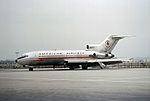1955 Cincinnati mid-air collision
1955 in KentuckyAccidents and incidents involving the Douglas DC-3Accidents and incidents involving the Martin 2-0-2Airliner accidents and incidents caused by pilot errorAirliner accidents and incidents in Kentucky ... and 9 more
Aviation accidents and incidents in KentuckyAviation accidents and incidents in the United States in 1955Cincinnati/Northern Kentucky International AirportJanuary 1955 events in the United KingdomMid-air collisionsMid-air collisions involving airlinersMid-air collisions involving general aviation aircraftTrans World Airlines accidents and incidentsTransportation in Boone County, Kentucky

The 1955 Cincinnati mid-air collision occurred on January 12, 1955, when Trans World Airlines Flight 694 Martin 2-0-2 on takeoff from Boone County Airport (now the Cincinnati/Northern Kentucky International Airport) collided in mid-air with a privately owned Douglas DC-3 that had entered the airport's control space without proper clearance. None of the occupants of either plane survived the collision.
Excerpt from the Wikipedia article 1955 Cincinnati mid-air collision (License: CC BY-SA 3.0, Authors, Images).1955 Cincinnati mid-air collision
Old Wendell Ford Boulevard,
Geographical coordinates (GPS) Address Website Nearby Places Show on map
Geographical coordinates (GPS)
| Latitude | Longitude |
|---|---|
| N 39.048888888889 ° | E -84.667777777778 ° |
Address
Cincinnati/Northern Kentucky International Airport (Greater Cincinnati International Airport)
Old Wendell Ford Boulevard
41025
Kentucky, United States
Open on Google Maps





